CSR Activities and Sustainable Objectives in Organizations Report
VerifiedAdded on 2023/04/05
|18
|3633
|439
Report
AI Summary
This report delves into the implementation of Corporate Social Responsibility (CSR) activities within organizations to meet sustainable objectives. It begins with establishing project aims, objectives, and timeframes, including a detailed project management plan covering cost, scope, time, quality, communication, risk, and resources. The report also incorporates a work breakdown structure and a Gantt chart for effective project management. The research employs both qualitative and quantitative methods to gather data and information, followed by an analysis of the research and data using appropriate tools and techniques. The report concludes with communicative recommendations based on the findings and a reflection on the value gained from conducting the project and its usefulness in supporting sustainable organizational performance. The report covers different aspects of CSR activities and provides detailed insights into how organizations can achieve sustainable goals through effective implementation strategies.
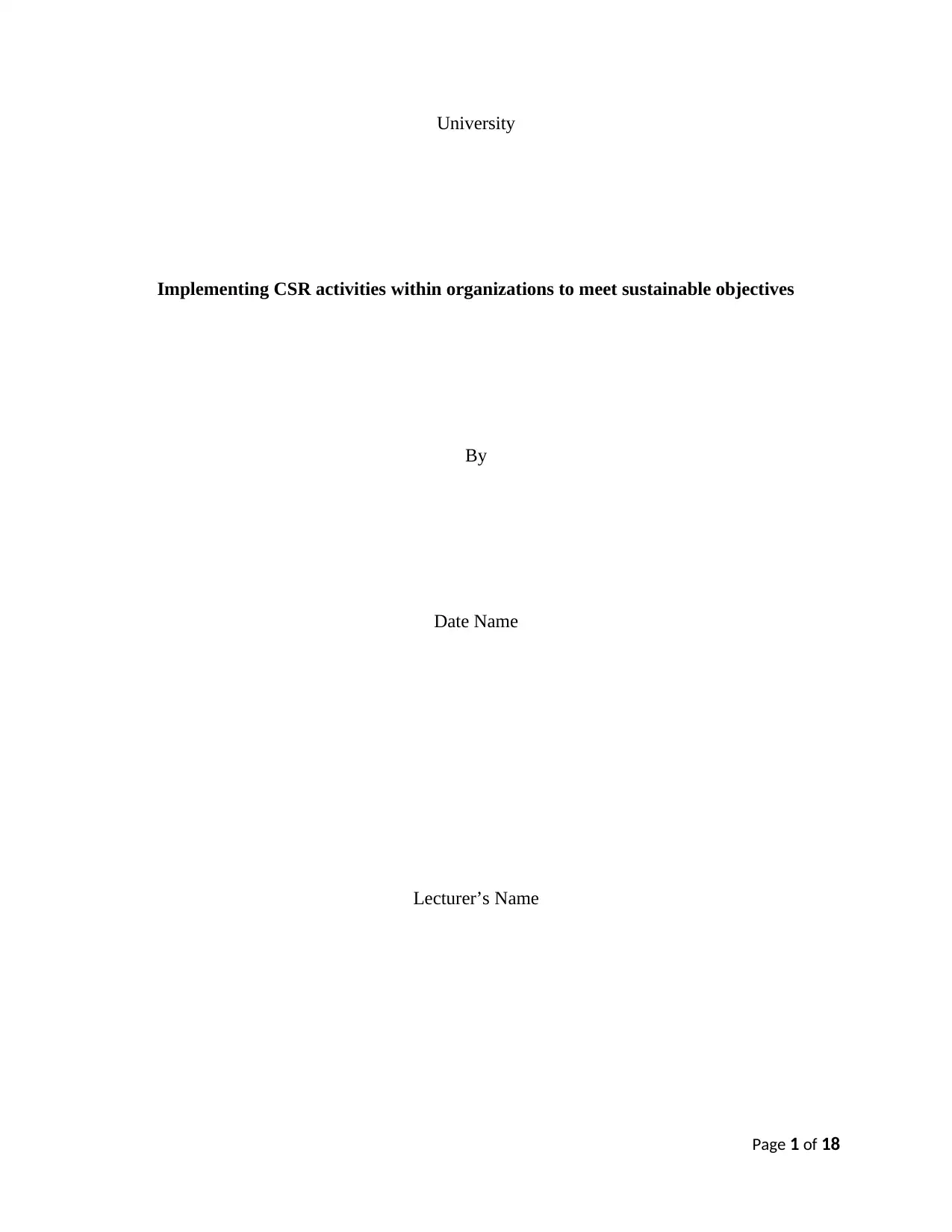
University
Implementing CSR activities within organizations to meet sustainable objectives
By
Date Name
Lecturer’s Name
Page 1 of 18
Implementing CSR activities within organizations to meet sustainable objectives
By
Date Name
Lecturer’s Name
Page 1 of 18
Paraphrase This Document
Need a fresh take? Get an instant paraphrase of this document with our AI Paraphraser
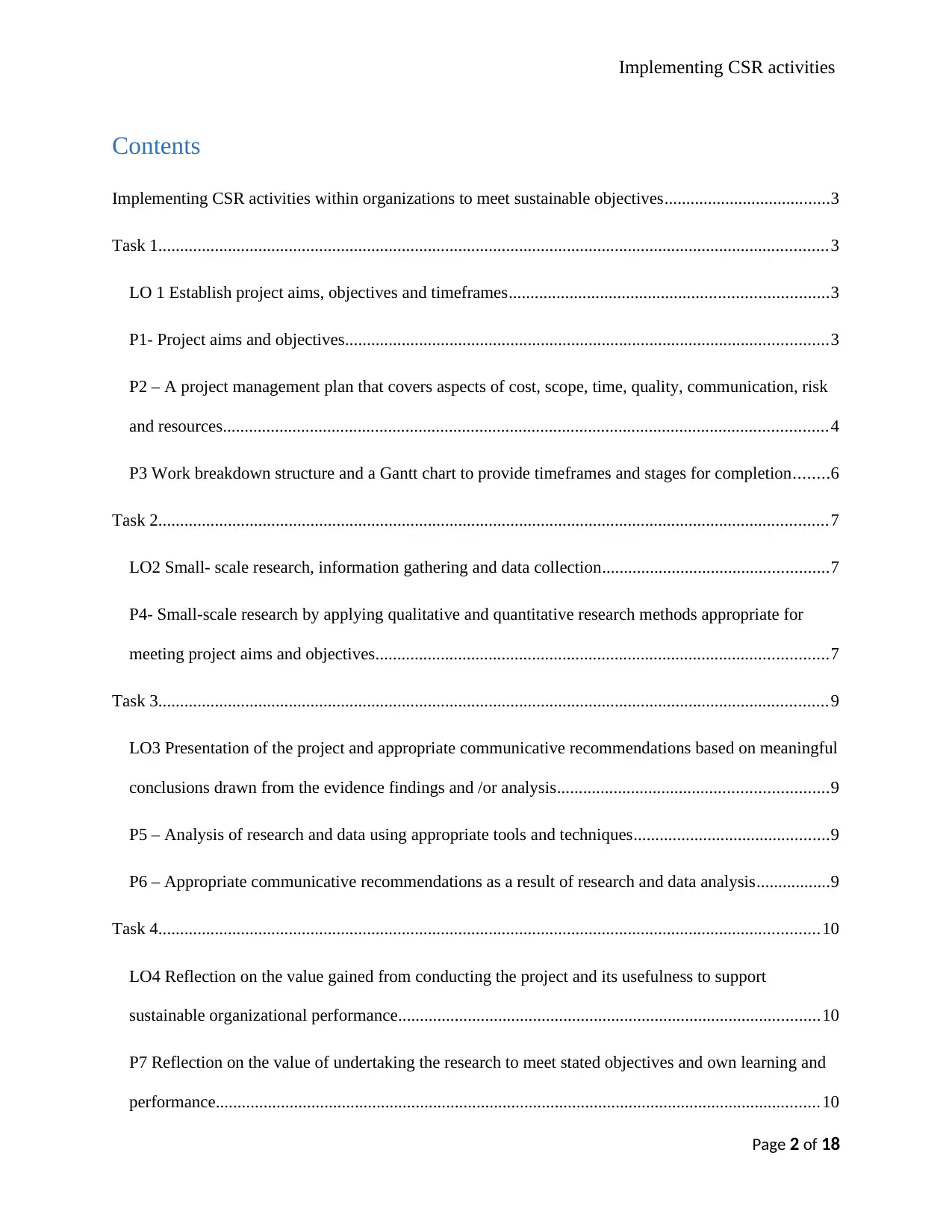
Implementing CSR activities
Contents
Implementing CSR activities within organizations to meet sustainable objectives......................................3
Task 1..........................................................................................................................................................3
LO 1 Establish project aims, objectives and timeframes.........................................................................3
P1- Project aims and objectives...............................................................................................................3
P2 – A project management plan that covers aspects of cost, scope, time, quality, communication, risk
and resources...........................................................................................................................................4
P3 Work breakdown structure and a Gantt chart to provide timeframes and stages for completion........6
Task 2..........................................................................................................................................................7
LO2 Small- scale research, information gathering and data collection....................................................7
P4- Small-scale research by applying qualitative and quantitative research methods appropriate for
meeting project aims and objectives........................................................................................................7
Task 3..........................................................................................................................................................9
LO3 Presentation of the project and appropriate communicative recommendations based on meaningful
conclusions drawn from the evidence findings and /or analysis..............................................................9
P5 – Analysis of research and data using appropriate tools and techniques.............................................9
P6 – Appropriate communicative recommendations as a result of research and data analysis.................9
Task 4........................................................................................................................................................10
LO4 Reflection on the value gained from conducting the project and its usefulness to support
sustainable organizational performance.................................................................................................10
P7 Reflection on the value of undertaking the research to meet stated objectives and own learning and
performance...........................................................................................................................................10
Page 2 of 18
Contents
Implementing CSR activities within organizations to meet sustainable objectives......................................3
Task 1..........................................................................................................................................................3
LO 1 Establish project aims, objectives and timeframes.........................................................................3
P1- Project aims and objectives...............................................................................................................3
P2 – A project management plan that covers aspects of cost, scope, time, quality, communication, risk
and resources...........................................................................................................................................4
P3 Work breakdown structure and a Gantt chart to provide timeframes and stages for completion........6
Task 2..........................................................................................................................................................7
LO2 Small- scale research, information gathering and data collection....................................................7
P4- Small-scale research by applying qualitative and quantitative research methods appropriate for
meeting project aims and objectives........................................................................................................7
Task 3..........................................................................................................................................................9
LO3 Presentation of the project and appropriate communicative recommendations based on meaningful
conclusions drawn from the evidence findings and /or analysis..............................................................9
P5 – Analysis of research and data using appropriate tools and techniques.............................................9
P6 – Appropriate communicative recommendations as a result of research and data analysis.................9
Task 4........................................................................................................................................................10
LO4 Reflection on the value gained from conducting the project and its usefulness to support
sustainable organizational performance.................................................................................................10
P7 Reflection on the value of undertaking the research to meet stated objectives and own learning and
performance...........................................................................................................................................10
Page 2 of 18
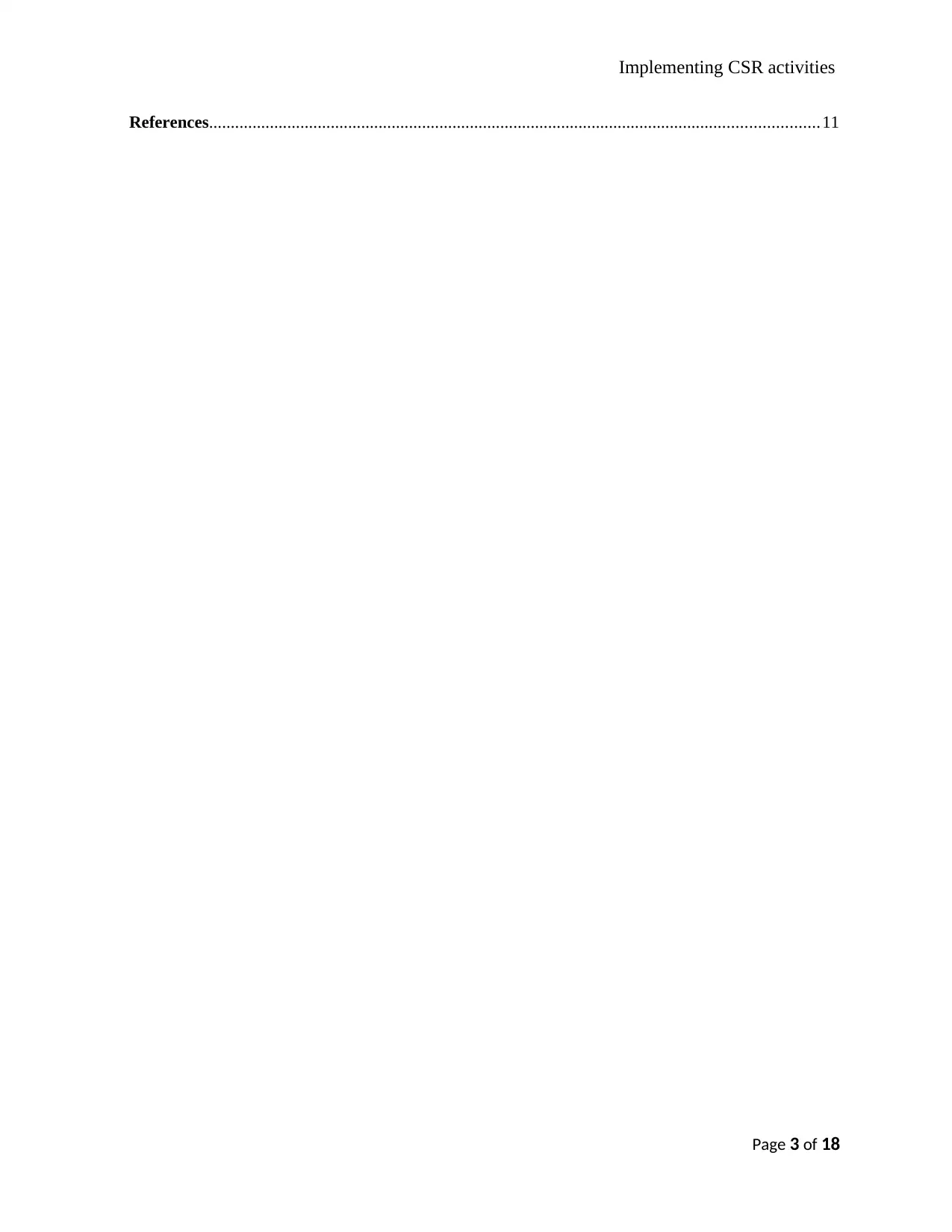
Implementing CSR activities
References............................................................................................................................................11
Page 3 of 18
References............................................................................................................................................11
Page 3 of 18
⊘ This is a preview!⊘
Do you want full access?
Subscribe today to unlock all pages.

Trusted by 1+ million students worldwide
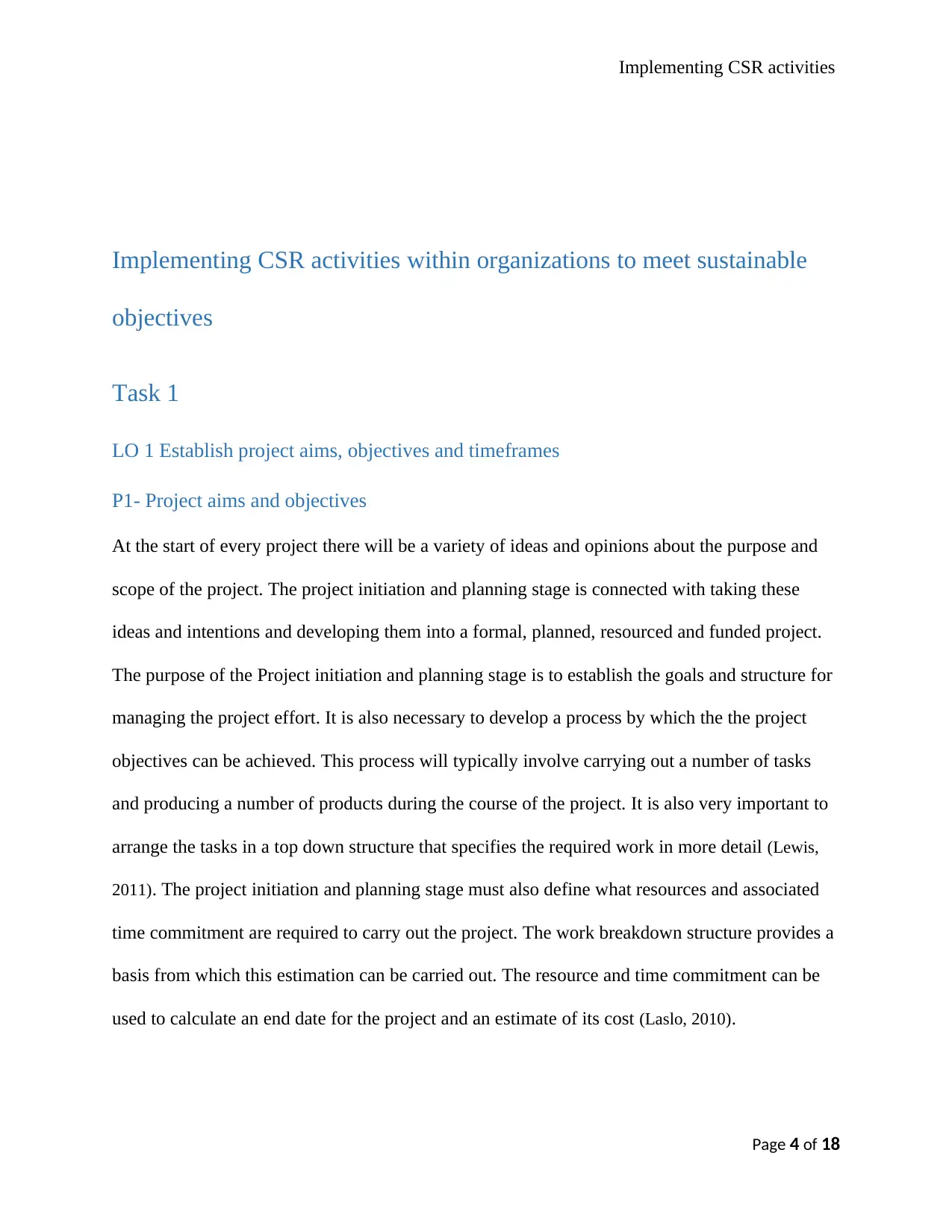
Implementing CSR activities
Implementing CSR activities within organizations to meet sustainable
objectives
Task 1
LO 1 Establish project aims, objectives and timeframes
P1- Project aims and objectives
At the start of every project there will be a variety of ideas and opinions about the purpose and
scope of the project. The project initiation and planning stage is connected with taking these
ideas and intentions and developing them into a formal, planned, resourced and funded project.
The purpose of the Project initiation and planning stage is to establish the goals and structure for
managing the project effort. It is also necessary to develop a process by which the the project
objectives can be achieved. This process will typically involve carrying out a number of tasks
and producing a number of products during the course of the project. It is also very important to
arrange the tasks in a top down structure that specifies the required work in more detail (Lewis,
2011). The project initiation and planning stage must also define what resources and associated
time commitment are required to carry out the project. The work breakdown structure provides a
basis from which this estimation can be carried out. The resource and time commitment can be
used to calculate an end date for the project and an estimate of its cost (Laslo, 2010).
Page 4 of 18
Implementing CSR activities within organizations to meet sustainable
objectives
Task 1
LO 1 Establish project aims, objectives and timeframes
P1- Project aims and objectives
At the start of every project there will be a variety of ideas and opinions about the purpose and
scope of the project. The project initiation and planning stage is connected with taking these
ideas and intentions and developing them into a formal, planned, resourced and funded project.
The purpose of the Project initiation and planning stage is to establish the goals and structure for
managing the project effort. It is also necessary to develop a process by which the the project
objectives can be achieved. This process will typically involve carrying out a number of tasks
and producing a number of products during the course of the project. It is also very important to
arrange the tasks in a top down structure that specifies the required work in more detail (Lewis,
2011). The project initiation and planning stage must also define what resources and associated
time commitment are required to carry out the project. The work breakdown structure provides a
basis from which this estimation can be carried out. The resource and time commitment can be
used to calculate an end date for the project and an estimate of its cost (Laslo, 2010).
Page 4 of 18
Paraphrase This Document
Need a fresh take? Get an instant paraphrase of this document with our AI Paraphraser
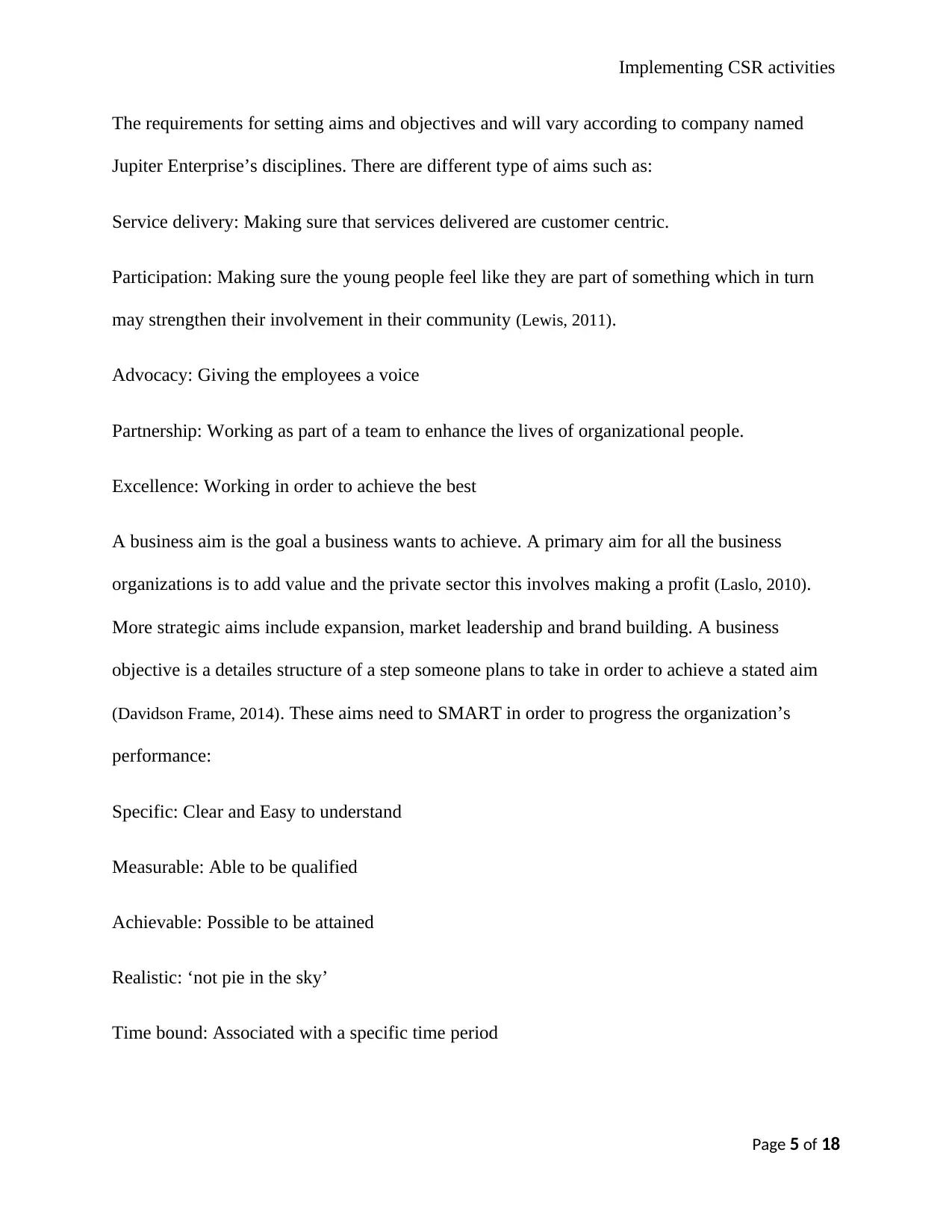
Implementing CSR activities
The requirements for setting aims and objectives and will vary according to company named
Jupiter Enterprise’s disciplines. There are different type of aims such as:
Service delivery: Making sure that services delivered are customer centric.
Participation: Making sure the young people feel like they are part of something which in turn
may strengthen their involvement in their community (Lewis, 2011).
Advocacy: Giving the employees a voice
Partnership: Working as part of a team to enhance the lives of organizational people.
Excellence: Working in order to achieve the best
A business aim is the goal a business wants to achieve. A primary aim for all the business
organizations is to add value and the private sector this involves making a profit (Laslo, 2010).
More strategic aims include expansion, market leadership and brand building. A business
objective is a detailes structure of a step someone plans to take in order to achieve a stated aim
(Davidson Frame, 2014). These aims need to SMART in order to progress the organization’s
performance:
Specific: Clear and Easy to understand
Measurable: Able to be qualified
Achievable: Possible to be attained
Realistic: ‘not pie in the sky’
Time bound: Associated with a specific time period
Page 5 of 18
The requirements for setting aims and objectives and will vary according to company named
Jupiter Enterprise’s disciplines. There are different type of aims such as:
Service delivery: Making sure that services delivered are customer centric.
Participation: Making sure the young people feel like they are part of something which in turn
may strengthen their involvement in their community (Lewis, 2011).
Advocacy: Giving the employees a voice
Partnership: Working as part of a team to enhance the lives of organizational people.
Excellence: Working in order to achieve the best
A business aim is the goal a business wants to achieve. A primary aim for all the business
organizations is to add value and the private sector this involves making a profit (Laslo, 2010).
More strategic aims include expansion, market leadership and brand building. A business
objective is a detailes structure of a step someone plans to take in order to achieve a stated aim
(Davidson Frame, 2014). These aims need to SMART in order to progress the organization’s
performance:
Specific: Clear and Easy to understand
Measurable: Able to be qualified
Achievable: Possible to be attained
Realistic: ‘not pie in the sky’
Time bound: Associated with a specific time period
Page 5 of 18
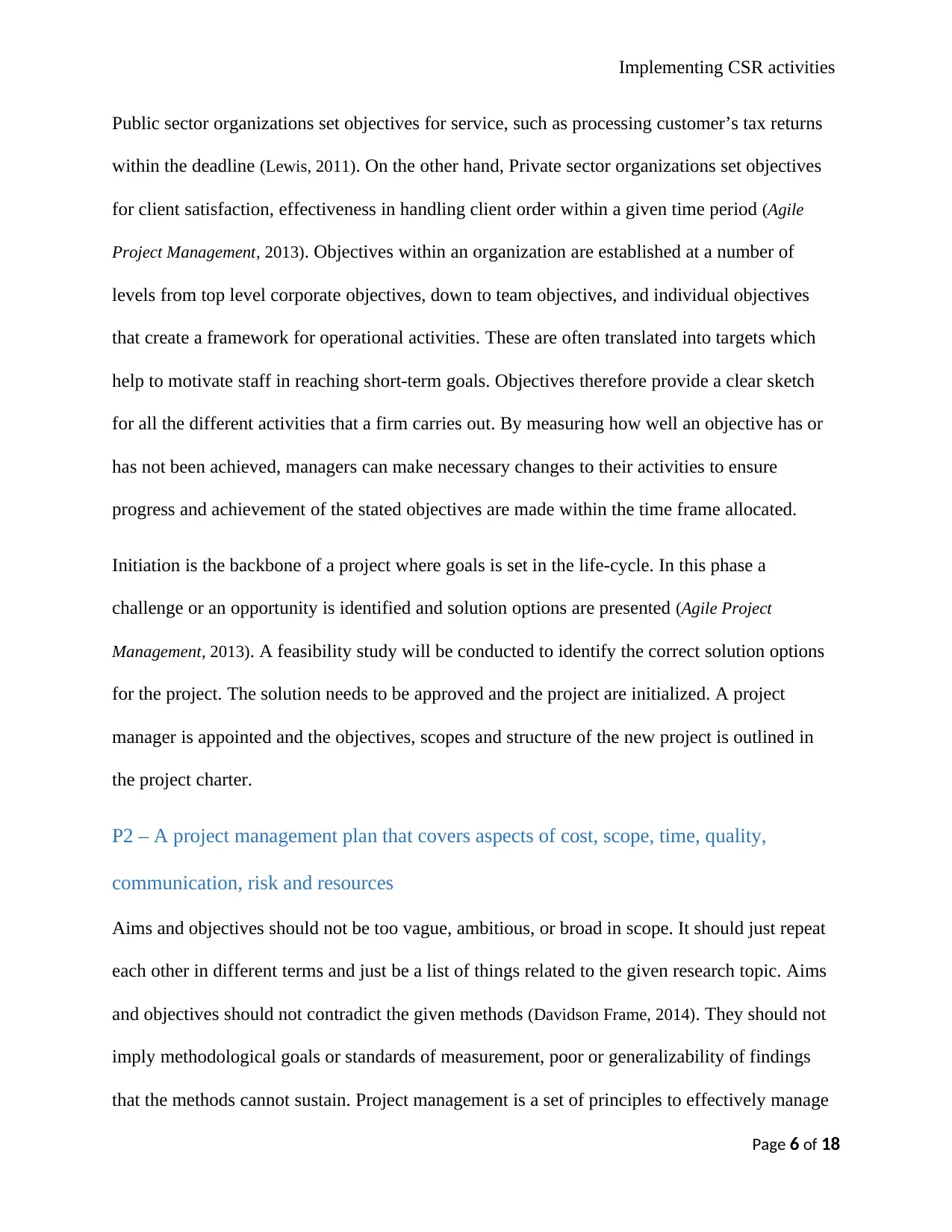
Implementing CSR activities
Public sector organizations set objectives for service, such as processing customer’s tax returns
within the deadline (Lewis, 2011). On the other hand, Private sector organizations set objectives
for client satisfaction, effectiveness in handling client order within a given time period (Agile
Project Management, 2013). Objectives within an organization are established at a number of
levels from top level corporate objectives, down to team objectives, and individual objectives
that create a framework for operational activities. These are often translated into targets which
help to motivate staff in reaching short-term goals. Objectives therefore provide a clear sketch
for all the different activities that a firm carries out. By measuring how well an objective has or
has not been achieved, managers can make necessary changes to their activities to ensure
progress and achievement of the stated objectives are made within the time frame allocated.
Initiation is the backbone of a project where goals is set in the life-cycle. In this phase a
challenge or an opportunity is identified and solution options are presented (Agile Project
Management, 2013). A feasibility study will be conducted to identify the correct solution options
for the project. The solution needs to be approved and the project are initialized. A project
manager is appointed and the objectives, scopes and structure of the new project is outlined in
the project charter.
P2 – A project management plan that covers aspects of cost, scope, time, quality,
communication, risk and resources
Aims and objectives should not be too vague, ambitious, or broad in scope. It should just repeat
each other in different terms and just be a list of things related to the given research topic. Aims
and objectives should not contradict the given methods (Davidson Frame, 2014). They should not
imply methodological goals or standards of measurement, poor or generalizability of findings
that the methods cannot sustain. Project management is a set of principles to effectively manage
Page 6 of 18
Public sector organizations set objectives for service, such as processing customer’s tax returns
within the deadline (Lewis, 2011). On the other hand, Private sector organizations set objectives
for client satisfaction, effectiveness in handling client order within a given time period (Agile
Project Management, 2013). Objectives within an organization are established at a number of
levels from top level corporate objectives, down to team objectives, and individual objectives
that create a framework for operational activities. These are often translated into targets which
help to motivate staff in reaching short-term goals. Objectives therefore provide a clear sketch
for all the different activities that a firm carries out. By measuring how well an objective has or
has not been achieved, managers can make necessary changes to their activities to ensure
progress and achievement of the stated objectives are made within the time frame allocated.
Initiation is the backbone of a project where goals is set in the life-cycle. In this phase a
challenge or an opportunity is identified and solution options are presented (Agile Project
Management, 2013). A feasibility study will be conducted to identify the correct solution options
for the project. The solution needs to be approved and the project are initialized. A project
manager is appointed and the objectives, scopes and structure of the new project is outlined in
the project charter.
P2 – A project management plan that covers aspects of cost, scope, time, quality,
communication, risk and resources
Aims and objectives should not be too vague, ambitious, or broad in scope. It should just repeat
each other in different terms and just be a list of things related to the given research topic. Aims
and objectives should not contradict the given methods (Davidson Frame, 2014). They should not
imply methodological goals or standards of measurement, poor or generalizability of findings
that the methods cannot sustain. Project management is a set of principles to effectively manage
Page 6 of 18
⊘ This is a preview!⊘
Do you want full access?
Subscribe today to unlock all pages.

Trusted by 1+ million students worldwide
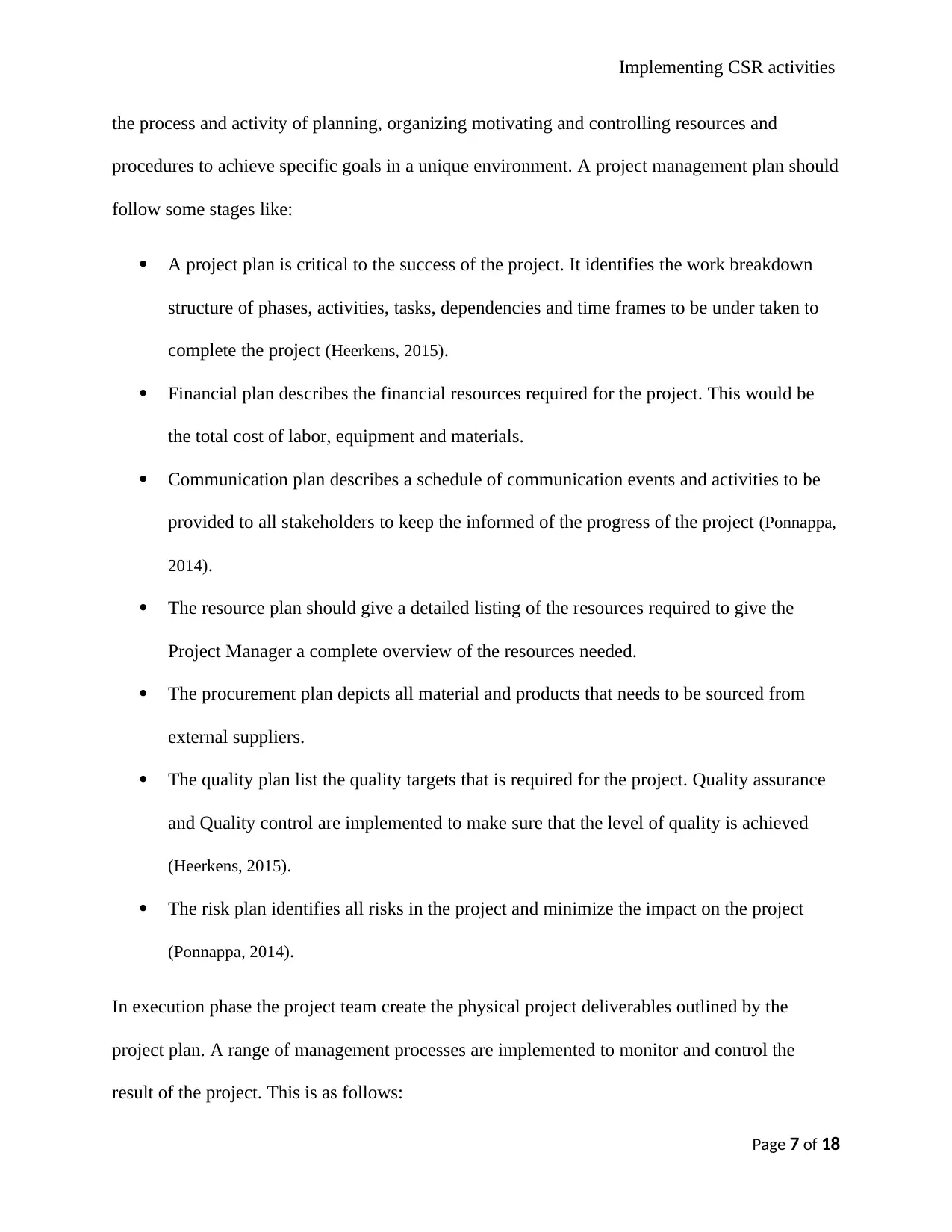
Implementing CSR activities
the process and activity of planning, organizing motivating and controlling resources and
procedures to achieve specific goals in a unique environment. A project management plan should
follow some stages like:
A project plan is critical to the success of the project. It identifies the work breakdown
structure of phases, activities, tasks, dependencies and time frames to be under taken to
complete the project (Heerkens, 2015).
Financial plan describes the financial resources required for the project. This would be
the total cost of labor, equipment and materials.
Communication plan describes a schedule of communication events and activities to be
provided to all stakeholders to keep the informed of the progress of the project (Ponnappa,
2014).
The resource plan should give a detailed listing of the resources required to give the
Project Manager a complete overview of the resources needed.
The procurement plan depicts all material and products that needs to be sourced from
external suppliers.
The quality plan list the quality targets that is required for the project. Quality assurance
and Quality control are implemented to make sure that the level of quality is achieved
(Heerkens, 2015).
The risk plan identifies all risks in the project and minimize the impact on the project
(Ponnappa, 2014).
In execution phase the project team create the physical project deliverables outlined by the
project plan. A range of management processes are implemented to monitor and control the
result of the project. This is as follows:
Page 7 of 18
the process and activity of planning, organizing motivating and controlling resources and
procedures to achieve specific goals in a unique environment. A project management plan should
follow some stages like:
A project plan is critical to the success of the project. It identifies the work breakdown
structure of phases, activities, tasks, dependencies and time frames to be under taken to
complete the project (Heerkens, 2015).
Financial plan describes the financial resources required for the project. This would be
the total cost of labor, equipment and materials.
Communication plan describes a schedule of communication events and activities to be
provided to all stakeholders to keep the informed of the progress of the project (Ponnappa,
2014).
The resource plan should give a detailed listing of the resources required to give the
Project Manager a complete overview of the resources needed.
The procurement plan depicts all material and products that needs to be sourced from
external suppliers.
The quality plan list the quality targets that is required for the project. Quality assurance
and Quality control are implemented to make sure that the level of quality is achieved
(Heerkens, 2015).
The risk plan identifies all risks in the project and minimize the impact on the project
(Ponnappa, 2014).
In execution phase the project team create the physical project deliverables outlined by the
project plan. A range of management processes are implemented to monitor and control the
result of the project. This is as follows:
Page 7 of 18
Paraphrase This Document
Need a fresh take? Get an instant paraphrase of this document with our AI Paraphraser
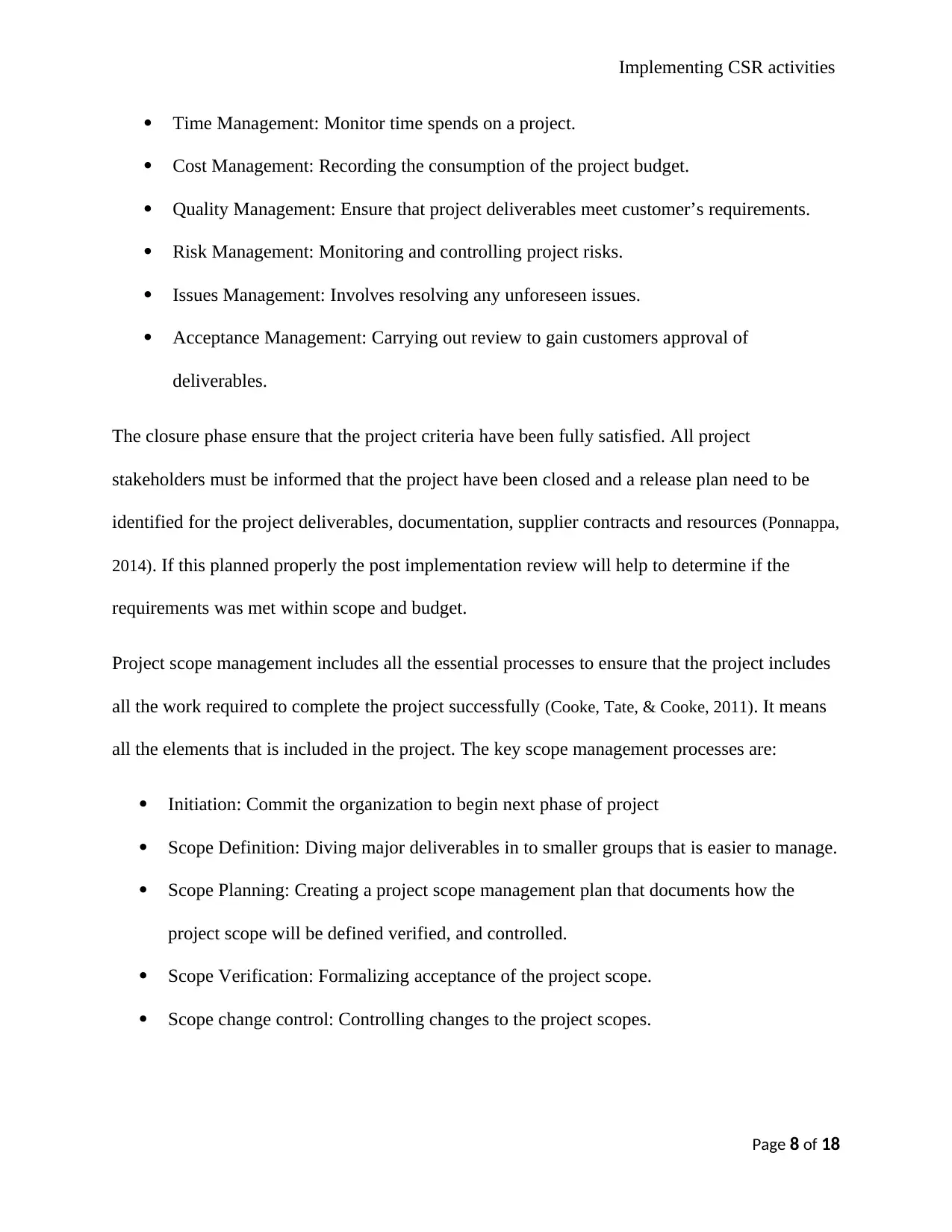
Implementing CSR activities
Time Management: Monitor time spends on a project.
Cost Management: Recording the consumption of the project budget.
Quality Management: Ensure that project deliverables meet customer’s requirements.
Risk Management: Monitoring and controlling project risks.
Issues Management: Involves resolving any unforeseen issues.
Acceptance Management: Carrying out review to gain customers approval of
deliverables.
The closure phase ensure that the project criteria have been fully satisfied. All project
stakeholders must be informed that the project have been closed and a release plan need to be
identified for the project deliverables, documentation, supplier contracts and resources (Ponnappa,
2014). If this planned properly the post implementation review will help to determine if the
requirements was met within scope and budget.
Project scope management includes all the essential processes to ensure that the project includes
all the work required to complete the project successfully (Cooke, Tate, & Cooke, 2011). It means
all the elements that is included in the project. The key scope management processes are:
Initiation: Commit the organization to begin next phase of project
Scope Definition: Diving major deliverables in to smaller groups that is easier to manage.
Scope Planning: Creating a project scope management plan that documents how the
project scope will be defined verified, and controlled.
Scope Verification: Formalizing acceptance of the project scope.
Scope change control: Controlling changes to the project scopes.
Page 8 of 18
Time Management: Monitor time spends on a project.
Cost Management: Recording the consumption of the project budget.
Quality Management: Ensure that project deliverables meet customer’s requirements.
Risk Management: Monitoring and controlling project risks.
Issues Management: Involves resolving any unforeseen issues.
Acceptance Management: Carrying out review to gain customers approval of
deliverables.
The closure phase ensure that the project criteria have been fully satisfied. All project
stakeholders must be informed that the project have been closed and a release plan need to be
identified for the project deliverables, documentation, supplier contracts and resources (Ponnappa,
2014). If this planned properly the post implementation review will help to determine if the
requirements was met within scope and budget.
Project scope management includes all the essential processes to ensure that the project includes
all the work required to complete the project successfully (Cooke, Tate, & Cooke, 2011). It means
all the elements that is included in the project. The key scope management processes are:
Initiation: Commit the organization to begin next phase of project
Scope Definition: Diving major deliverables in to smaller groups that is easier to manage.
Scope Planning: Creating a project scope management plan that documents how the
project scope will be defined verified, and controlled.
Scope Verification: Formalizing acceptance of the project scope.
Scope change control: Controlling changes to the project scopes.
Page 8 of 18
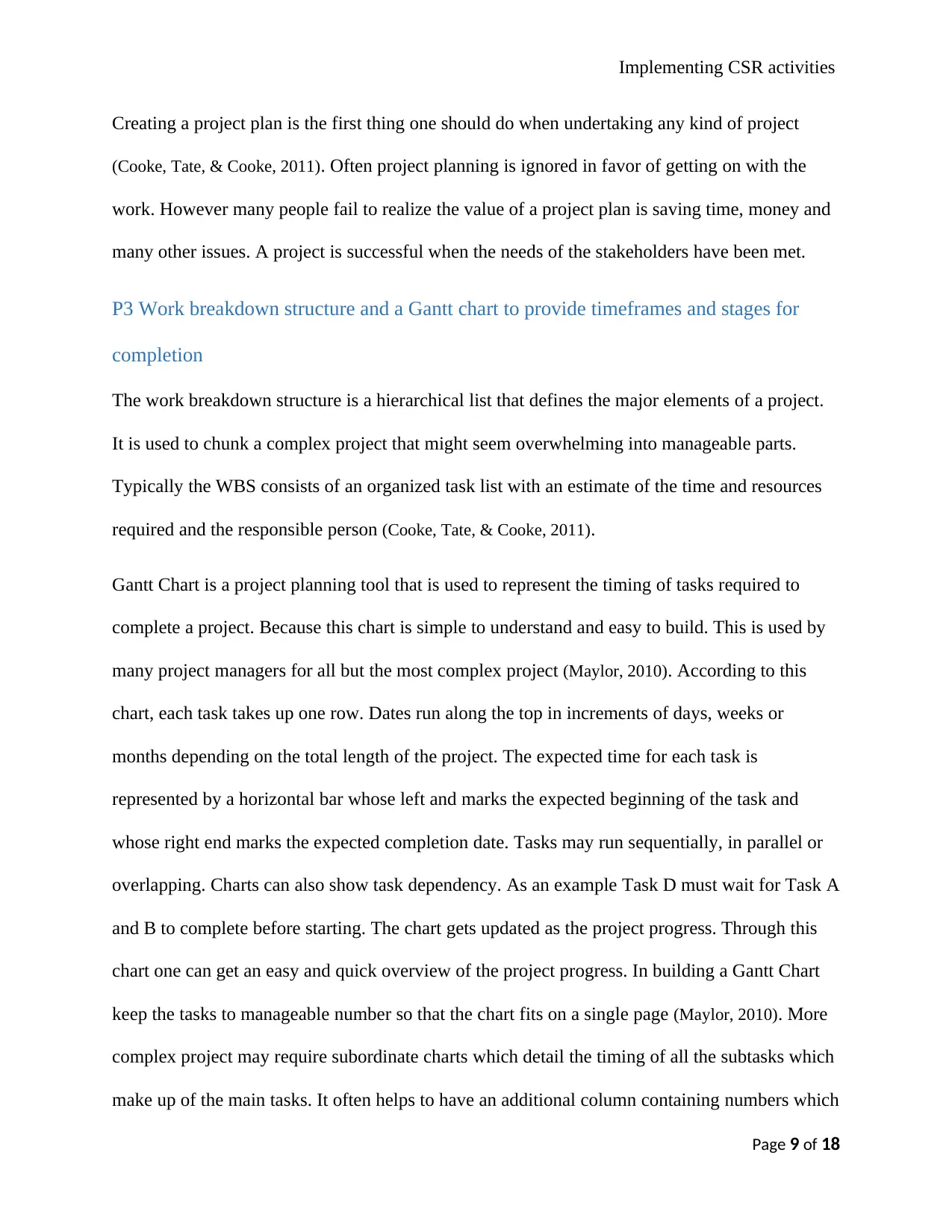
Implementing CSR activities
Creating a project plan is the first thing one should do when undertaking any kind of project
(Cooke, Tate, & Cooke, 2011). Often project planning is ignored in favor of getting on with the
work. However many people fail to realize the value of a project plan is saving time, money and
many other issues. A project is successful when the needs of the stakeholders have been met.
P3 Work breakdown structure and a Gantt chart to provide timeframes and stages for
completion
The work breakdown structure is a hierarchical list that defines the major elements of a project.
It is used to chunk a complex project that might seem overwhelming into manageable parts.
Typically the WBS consists of an organized task list with an estimate of the time and resources
required and the responsible person (Cooke, Tate, & Cooke, 2011).
Gantt Chart is a project planning tool that is used to represent the timing of tasks required to
complete a project. Because this chart is simple to understand and easy to build. This is used by
many project managers for all but the most complex project (Maylor, 2010). According to this
chart, each task takes up one row. Dates run along the top in increments of days, weeks or
months depending on the total length of the project. The expected time for each task is
represented by a horizontal bar whose left and marks the expected beginning of the task and
whose right end marks the expected completion date. Tasks may run sequentially, in parallel or
overlapping. Charts can also show task dependency. As an example Task D must wait for Task A
and B to complete before starting. The chart gets updated as the project progress. Through this
chart one can get an easy and quick overview of the project progress. In building a Gantt Chart
keep the tasks to manageable number so that the chart fits on a single page (Maylor, 2010). More
complex project may require subordinate charts which detail the timing of all the subtasks which
make up of the main tasks. It often helps to have an additional column containing numbers which
Page 9 of 18
Creating a project plan is the first thing one should do when undertaking any kind of project
(Cooke, Tate, & Cooke, 2011). Often project planning is ignored in favor of getting on with the
work. However many people fail to realize the value of a project plan is saving time, money and
many other issues. A project is successful when the needs of the stakeholders have been met.
P3 Work breakdown structure and a Gantt chart to provide timeframes and stages for
completion
The work breakdown structure is a hierarchical list that defines the major elements of a project.
It is used to chunk a complex project that might seem overwhelming into manageable parts.
Typically the WBS consists of an organized task list with an estimate of the time and resources
required and the responsible person (Cooke, Tate, & Cooke, 2011).
Gantt Chart is a project planning tool that is used to represent the timing of tasks required to
complete a project. Because this chart is simple to understand and easy to build. This is used by
many project managers for all but the most complex project (Maylor, 2010). According to this
chart, each task takes up one row. Dates run along the top in increments of days, weeks or
months depending on the total length of the project. The expected time for each task is
represented by a horizontal bar whose left and marks the expected beginning of the task and
whose right end marks the expected completion date. Tasks may run sequentially, in parallel or
overlapping. Charts can also show task dependency. As an example Task D must wait for Task A
and B to complete before starting. The chart gets updated as the project progress. Through this
chart one can get an easy and quick overview of the project progress. In building a Gantt Chart
keep the tasks to manageable number so that the chart fits on a single page (Maylor, 2010). More
complex project may require subordinate charts which detail the timing of all the subtasks which
make up of the main tasks. It often helps to have an additional column containing numbers which
Page 9 of 18
⊘ This is a preview!⊘
Do you want full access?
Subscribe today to unlock all pages.

Trusted by 1+ million students worldwide
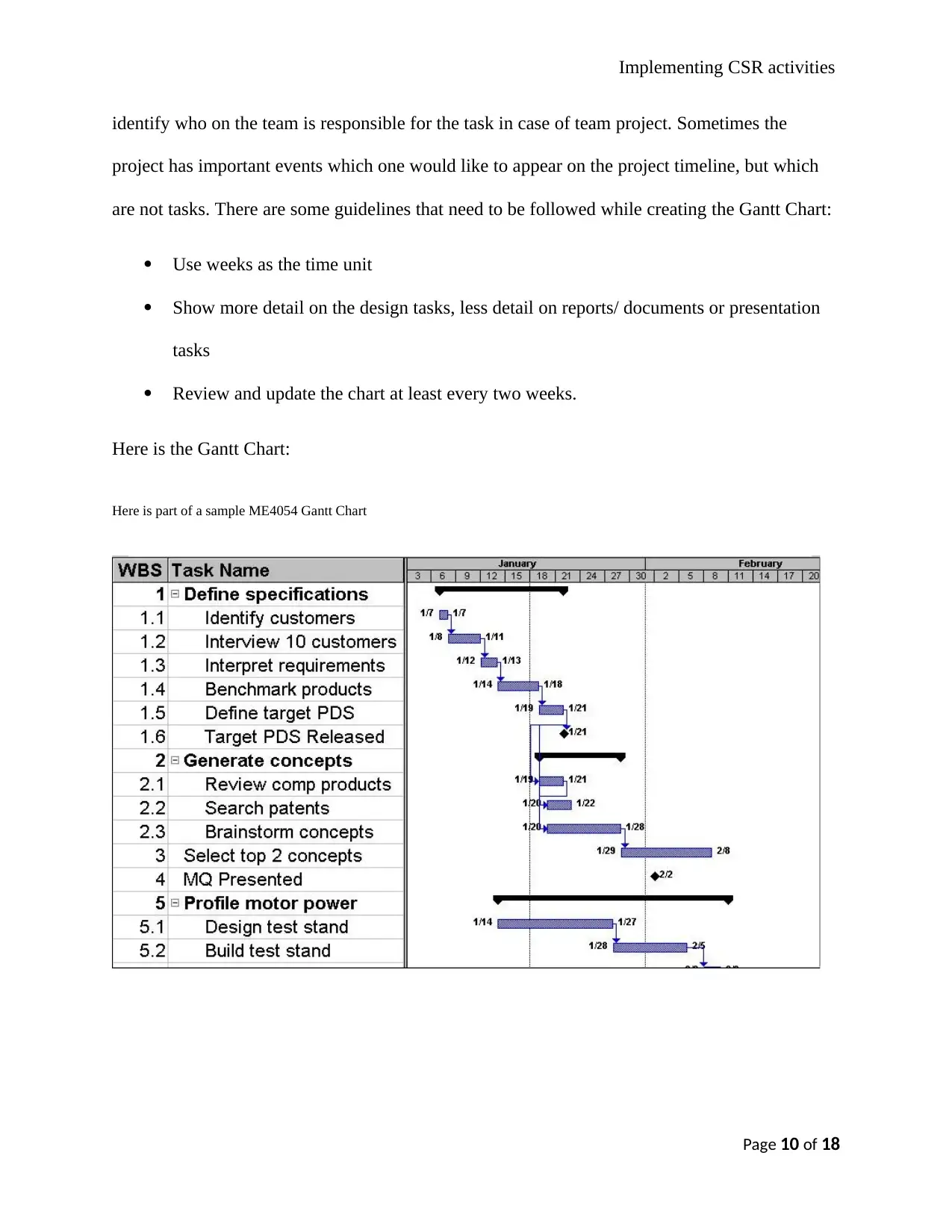
Implementing CSR activities
identify who on the team is responsible for the task in case of team project. Sometimes the
project has important events which one would like to appear on the project timeline, but which
are not tasks. There are some guidelines that need to be followed while creating the Gantt Chart:
Use weeks as the time unit
Show more detail on the design tasks, less detail on reports/ documents or presentation
tasks
Review and update the chart at least every two weeks.
Here is the Gantt Chart:
Here is part of a sample ME4054 Gantt Chart
Page 10 of 18
identify who on the team is responsible for the task in case of team project. Sometimes the
project has important events which one would like to appear on the project timeline, but which
are not tasks. There are some guidelines that need to be followed while creating the Gantt Chart:
Use weeks as the time unit
Show more detail on the design tasks, less detail on reports/ documents or presentation
tasks
Review and update the chart at least every two weeks.
Here is the Gantt Chart:
Here is part of a sample ME4054 Gantt Chart
Page 10 of 18
Paraphrase This Document
Need a fresh take? Get an instant paraphrase of this document with our AI Paraphraser
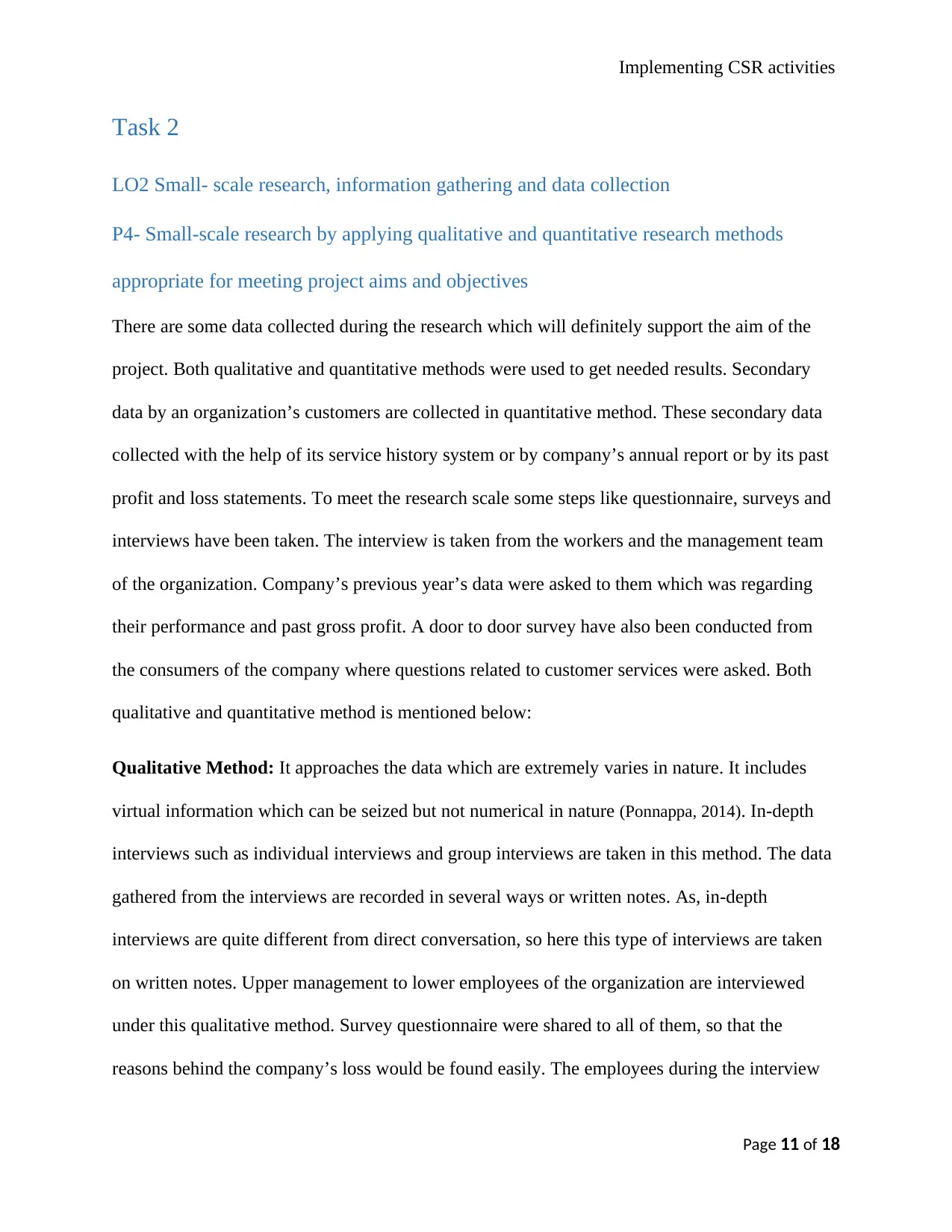
Implementing CSR activities
Task 2
LO2 Small- scale research, information gathering and data collection
P4- Small-scale research by applying qualitative and quantitative research methods
appropriate for meeting project aims and objectives
There are some data collected during the research which will definitely support the aim of the
project. Both qualitative and quantitative methods were used to get needed results. Secondary
data by an organization’s customers are collected in quantitative method. These secondary data
collected with the help of its service history system or by company’s annual report or by its past
profit and loss statements. To meet the research scale some steps like questionnaire, surveys and
interviews have been taken. The interview is taken from the workers and the management team
of the organization. Company’s previous year’s data were asked to them which was regarding
their performance and past gross profit. A door to door survey have also been conducted from
the consumers of the company where questions related to customer services were asked. Both
qualitative and quantitative method is mentioned below:
Qualitative Method: It approaches the data which are extremely varies in nature. It includes
virtual information which can be seized but not numerical in nature (Ponnappa, 2014). In-depth
interviews such as individual interviews and group interviews are taken in this method. The data
gathered from the interviews are recorded in several ways or written notes. As, in-depth
interviews are quite different from direct conversation, so here this type of interviews are taken
on written notes. Upper management to lower employees of the organization are interviewed
under this qualitative method. Survey questionnaire were shared to all of them, so that the
reasons behind the company’s loss would be found easily. The employees during the interview
Page 11 of 18
Task 2
LO2 Small- scale research, information gathering and data collection
P4- Small-scale research by applying qualitative and quantitative research methods
appropriate for meeting project aims and objectives
There are some data collected during the research which will definitely support the aim of the
project. Both qualitative and quantitative methods were used to get needed results. Secondary
data by an organization’s customers are collected in quantitative method. These secondary data
collected with the help of its service history system or by company’s annual report or by its past
profit and loss statements. To meet the research scale some steps like questionnaire, surveys and
interviews have been taken. The interview is taken from the workers and the management team
of the organization. Company’s previous year’s data were asked to them which was regarding
their performance and past gross profit. A door to door survey have also been conducted from
the consumers of the company where questions related to customer services were asked. Both
qualitative and quantitative method is mentioned below:
Qualitative Method: It approaches the data which are extremely varies in nature. It includes
virtual information which can be seized but not numerical in nature (Ponnappa, 2014). In-depth
interviews such as individual interviews and group interviews are taken in this method. The data
gathered from the interviews are recorded in several ways or written notes. As, in-depth
interviews are quite different from direct conversation, so here this type of interviews are taken
on written notes. Upper management to lower employees of the organization are interviewed
under this qualitative method. Survey questionnaire were shared to all of them, so that the
reasons behind the company’s loss would be found easily. The employees during the interview
Page 11 of 18
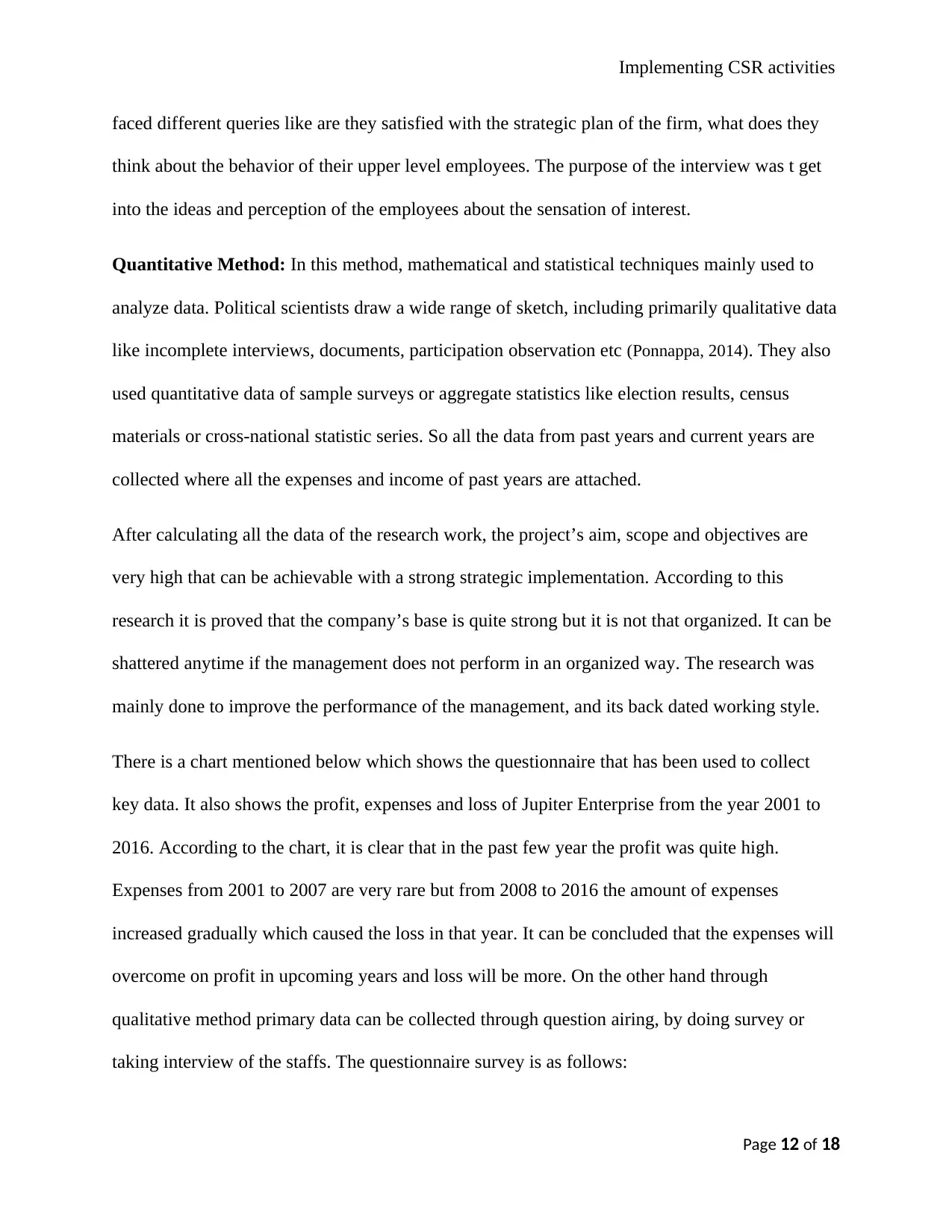
Implementing CSR activities
faced different queries like are they satisfied with the strategic plan of the firm, what does they
think about the behavior of their upper level employees. The purpose of the interview was t get
into the ideas and perception of the employees about the sensation of interest.
Quantitative Method: In this method, mathematical and statistical techniques mainly used to
analyze data. Political scientists draw a wide range of sketch, including primarily qualitative data
like incomplete interviews, documents, participation observation etc (Ponnappa, 2014). They also
used quantitative data of sample surveys or aggregate statistics like election results, census
materials or cross-national statistic series. So all the data from past years and current years are
collected where all the expenses and income of past years are attached.
After calculating all the data of the research work, the project’s aim, scope and objectives are
very high that can be achievable with a strong strategic implementation. According to this
research it is proved that the company’s base is quite strong but it is not that organized. It can be
shattered anytime if the management does not perform in an organized way. The research was
mainly done to improve the performance of the management, and its back dated working style.
There is a chart mentioned below which shows the questionnaire that has been used to collect
key data. It also shows the profit, expenses and loss of Jupiter Enterprise from the year 2001 to
2016. According to the chart, it is clear that in the past few year the profit was quite high.
Expenses from 2001 to 2007 are very rare but from 2008 to 2016 the amount of expenses
increased gradually which caused the loss in that year. It can be concluded that the expenses will
overcome on profit in upcoming years and loss will be more. On the other hand through
qualitative method primary data can be collected through question airing, by doing survey or
taking interview of the staffs. The questionnaire survey is as follows:
Page 12 of 18
faced different queries like are they satisfied with the strategic plan of the firm, what does they
think about the behavior of their upper level employees. The purpose of the interview was t get
into the ideas and perception of the employees about the sensation of interest.
Quantitative Method: In this method, mathematical and statistical techniques mainly used to
analyze data. Political scientists draw a wide range of sketch, including primarily qualitative data
like incomplete interviews, documents, participation observation etc (Ponnappa, 2014). They also
used quantitative data of sample surveys or aggregate statistics like election results, census
materials or cross-national statistic series. So all the data from past years and current years are
collected where all the expenses and income of past years are attached.
After calculating all the data of the research work, the project’s aim, scope and objectives are
very high that can be achievable with a strong strategic implementation. According to this
research it is proved that the company’s base is quite strong but it is not that organized. It can be
shattered anytime if the management does not perform in an organized way. The research was
mainly done to improve the performance of the management, and its back dated working style.
There is a chart mentioned below which shows the questionnaire that has been used to collect
key data. It also shows the profit, expenses and loss of Jupiter Enterprise from the year 2001 to
2016. According to the chart, it is clear that in the past few year the profit was quite high.
Expenses from 2001 to 2007 are very rare but from 2008 to 2016 the amount of expenses
increased gradually which caused the loss in that year. It can be concluded that the expenses will
overcome on profit in upcoming years and loss will be more. On the other hand through
qualitative method primary data can be collected through question airing, by doing survey or
taking interview of the staffs. The questionnaire survey is as follows:
Page 12 of 18
⊘ This is a preview!⊘
Do you want full access?
Subscribe today to unlock all pages.

Trusted by 1+ million students worldwide
1 out of 18
Related Documents
Your All-in-One AI-Powered Toolkit for Academic Success.
+13062052269
info@desklib.com
Available 24*7 on WhatsApp / Email
![[object Object]](/_next/static/media/star-bottom.7253800d.svg)
Unlock your academic potential
Copyright © 2020–2025 A2Z Services. All Rights Reserved. Developed and managed by ZUCOL.





